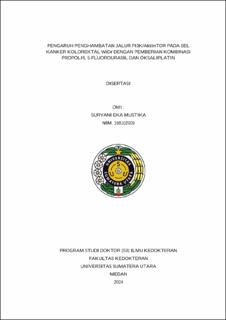| dc.description.abstract | Background: The incidence of colorectal cancer continues to rise, with the majority of patients developing metastases. Chemotherapy, including the use of cytostatics, presents challenges due to the emergence of chemoresistance. 5-
Flourouracyl (5-fu) and oxaliplatin have been utilized as standard chemotherapy treatments for colorectal cancer for an extended period. The combination of natural ingredients, such as propolis, with chemotherapy as co-chemotherapy is anticipated to mitigate the adverse effects of cytostatic drugs while enhancing treatment efficacy. In vitro studies have demonstrated the inhibitory effects of propolis on the cell cycle and apoptosis. Research objective: to analyze the impact of inhibiting the PI3K/Akt/mTOR pathway on WiDr colorectal cancer cells through the administration of propolis, 5-
fu and oxaliplatin.
Research methods:
This research is an experimental, exploratory laboratory study with the objective of proving the effect of 5-fu, oxaliplatin and propolis via the PI3K/Akt/mTOR pathway on WiDr colorectal cancer in vitro. All samples received parallel treatment using a PostTest Only Control Group Design. Testing for apoptosis, cell cycle, PI3K, Akt, mTOR, cyclin D1, p53 and ROS was conducted using the flow cytometry method. The number of cells required for the apoptosis test is 5 x 10⁵ cells/well, which are then planted in a 6-well microplate and incubated for 24 hours. Data analysis is conducted using One Way ANOVA, Kruskal Wallis, and Post Hoc tests.
Results : the combination of propolis and oxaliplatin provides the most effective inhibition of PI3K in WiDr cells. The combination of propolis and 5-fluorouracil (5-FU) demonstrated a potentiation effect in Akt inhibition, exhibiting a synergistic effect compared to the combination of two cytostatics. Similarly, the combination
of propolis and 5-FU exhibited a potentiation effect in mammalian target of rapamycin (mTOR) inhibition, demonstrating a synergistic effect compared to the combination of two cytostatics. The combination of three ingredients demonstrated
the most effective mTOR inhibition when the concentration of propolis was 7.5
μg/mL, oxaliplatin was 2.5 μg/mL, and 5-Fu was 10 μg/mL.
Conclusion: Propolis administration has an effect on the mTOR pathway. | en_US |


